
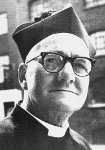 Father Joe - Joseph
Williamson MBE (1895-1988)
Father Joe - Joseph
Williamson MBE (1895-1988)
 Joseph
Williamson was born at 75 Arcadia Street, Poplar, where his
widowed mother, on whom he doted all his life (calling her one of
nature's greatest ladies), brought up eight
children (three others died in infancy) in two rooms. She could not
read or write, and relied on one of her daughters to deal with
correspondence. The boys slept in
two beds in a tiny room; I can't
remember where the others slept.
When Joe was 3, his father had been crushed to death in the mud of East
India Docks in a shipbreaking accident, when a boiler collapsed. Mother
refused to let the younger children go to Langley House, the East
London orphanage, and never managed to qualify for charity despite
their desperate poverty since the children and their clothes were
always clean (Good Gawd, soap's cheap
enough, she said) and they had
boots - of a sort. She got by taking in mounds of washing and ironing,
and starved herself when food was short. But Joe insisted it was a
happy home, despite the fact that one brother was sent to a reformatory
(where he was unjustly birched) and two others later took refuge in
drink. He was rightly proud of his roots.
Joseph
Williamson was born at 75 Arcadia Street, Poplar, where his
widowed mother, on whom he doted all his life (calling her one of
nature's greatest ladies), brought up eight
children (three others died in infancy) in two rooms. She could not
read or write, and relied on one of her daughters to deal with
correspondence. The boys slept in
two beds in a tiny room; I can't
remember where the others slept.
When Joe was 3, his father had been crushed to death in the mud of East
India Docks in a shipbreaking accident, when a boiler collapsed. Mother
refused to let the younger children go to Langley House, the East
London orphanage, and never managed to qualify for charity despite
their desperate poverty since the children and their clothes were
always clean (Good Gawd, soap's cheap
enough, she said) and they had
boots - of a sort. She got by taking in mounds of washing and ironing,
and starved herself when food was short. But Joe insisted it was a
happy home, despite the fact that one brother was sent to a reformatory
(where he was unjustly birched) and two others later took refuge in
drink. He was rightly proud of his roots.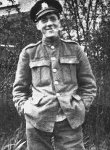 After school, he
spent six months in service, as a page boy at Radlett
- hard work and good food, but he was sacked after six months. He then
worked as a clerk at Cubitts, and at the Civil Service Stores in
Haymarket, with a short spell working at the home of a suffragette in
Southminster, but this did not work out: he was too ready to speak his
mind, and, being short-sighted, was clumsy. (His eyesight remained a
problem all his life.) These posts had been arranged by Fr Dawson. His
successor, Fr Lambert, also took Joe under his wing and became a kind
of guardian. F.R. Barry (later
Bishop of Southwell) was his
chaplain for a time. Fr Joe
said in his autobigraphy that when he signed up for the Army in 1914,
serving in France, he found
the routine, and the regular food and pay, congenial, and missed it
when he was demobbed. However, in the (unpublished) first draft he says
that he hated his time in France and was terrified; he was bitter about
Earl Haig's command which ordered thousands of men 'over the top' to
their deaths, and considered him to be a criminal. He had great respect
for Philip 'Tubby'
Clayton and the help TocH brought to the troops, and for the
ministry of those like 'Woodbine Willie', the Revd Geoffrey
Studdart Kennedy, who stood up for the men against the officers and
the
system.
After school, he
spent six months in service, as a page boy at Radlett
- hard work and good food, but he was sacked after six months. He then
worked as a clerk at Cubitts, and at the Civil Service Stores in
Haymarket, with a short spell working at the home of a suffragette in
Southminster, but this did not work out: he was too ready to speak his
mind, and, being short-sighted, was clumsy. (His eyesight remained a
problem all his life.) These posts had been arranged by Fr Dawson. His
successor, Fr Lambert, also took Joe under his wing and became a kind
of guardian. F.R. Barry (later
Bishop of Southwell) was his
chaplain for a time. Fr Joe
said in his autobigraphy that when he signed up for the Army in 1914,
serving in France, he found
the routine, and the regular food and pay, congenial, and missed it
when he was demobbed. However, in the (unpublished) first draft he says
that he hated his time in France and was terrified; he was bitter about
Earl Haig's command which ordered thousands of men 'over the top' to
their deaths, and considered him to be a criminal. He had great respect
for Philip 'Tubby'
Clayton and the help TocH brought to the troops, and for the
ministry of those like 'Woodbine Willie', the Revd Geoffrey
Studdart Kennedy, who stood up for the men against the officers and
the
system.

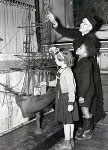 In
1952 a friend put his name forward for St Paul Dock Street with
St Mark Whitechapel, saying 'It's about time you returned to London'.
(In later life, he often commented that he was never offered a parish
by a bishop, but only by patrons!) Though a 'Catholic' (but not in the
'party' sense - see below), he was appointed to what had been an
Evangelical church, and got to grips with the poverty and deprivation
of the area, and set about restoring the church. The ship's weathervane
which topped the spire was taken down for cleaning and regilding, and
he toured it round the parish on a cart fundraising.
In
1952 a friend put his name forward for St Paul Dock Street with
St Mark Whitechapel, saying 'It's about time you returned to London'.
(In later life, he often commented that he was never offered a parish
by a bishop, but only by patrons!) Though a 'Catholic' (but not in the
'party' sense - see below), he was appointed to what had been an
Evangelical church, and got to grips with the poverty and deprivation
of the area, and set about restoring the church. The ship's weathervane
which topped the spire was taken down for cleaning and regilding, and
he toured it round the parish on a cart fundraising. 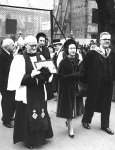
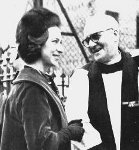
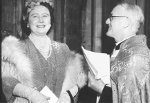
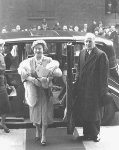 Mindful of
his own childhood at St Saviour's, he
valued the fact that St Paul's had a church school, and had a
special care for it. Princess Margaret came to open the new school hall
in 1962. (Some years later, when St Paul's closed, the restored ship [pictured above] was
removed from the church spire and mounted on the outside wall of the
hall - appropriately, though without official permission, prompting a
firm rebuke from the then-Rector of St George's.) Six years earlier, in
1956, the Queen Mother had visited the parish on St George's Day to unveil a memorial
window to Admiral Woods.
Mindful of
his own childhood at St Saviour's, he
valued the fact that St Paul's had a church school, and had a
special care for it. Princess Margaret came to open the new school hall
in 1962. (Some years later, when St Paul's closed, the restored ship [pictured above] was
removed from the church spire and mounted on the outside wall of the
hall - appropriately, though without official permission, prompting a
firm rebuke from the then-Rector of St George's.) Six years earlier, in
1956, the Queen Mother had visited the parish on St George's Day to unveil a memorial
window to Admiral Woods.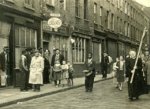
 He introduced a Good Friday walk of witness
through the streets (which became a deanery event). Cable
Street, a
thoroughfare that had become world-famous as a result of the riots 30
years ealier, and in his time had been taken over by a bewildering
variety of African and European all-night cafés, knocking
shops,
robber landlords and drug dealers, became a true Via Dolorosa. He
was a keen
visitor, and always ready (with Audrey's help, and that of his
now-adult children) to
welcome people into the vicarage. His son Tony (holding the cross in the second picture) was
ordained in 1961 and served as a worker priest (one of the relatively
few to make sense of this vocation), a Labour councillor and Diocesan
Director of Education for Oxford before his retirement. He and his
family revisited the area a few years ago to walk the streets and see how much
life has changed hereabouts, and visited the current occupants of the former Vicarage.
He introduced a Good Friday walk of witness
through the streets (which became a deanery event). Cable
Street, a
thoroughfare that had become world-famous as a result of the riots 30
years ealier, and in his time had been taken over by a bewildering
variety of African and European all-night cafés, knocking
shops,
robber landlords and drug dealers, became a true Via Dolorosa. He
was a keen
visitor, and always ready (with Audrey's help, and that of his
now-adult children) to
welcome people into the vicarage. His son Tony (holding the cross in the second picture) was
ordained in 1961 and served as a worker priest (one of the relatively
few to make sense of this vocation), a Labour councillor and Diocesan
Director of Education for Oxford before his retirement. He and his
family revisited the area a few years ago to walk the streets and see how much
life has changed hereabouts, and visited the current occupants of the former Vicarage.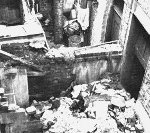
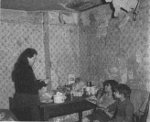
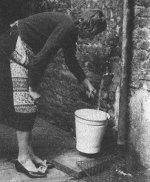
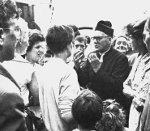 He was appalled by, and documented, the slum housing conditions of the
parish, and wrote many letters to the authorities. He took on the slum
landlords who were rife in the area. He challenged Henry Brooke, the
housing minister, to walk round the parish with him - He would be sickened and
shocked. On one occasion, in his last year
at St Paul's, he even swallowed his ardent royalist and anti-communist
principles by encouraging church folk to vote for the atheist and
communist councillor Solly Kaye, after he had craftily saved Eileen
Mansions from falling into their hands. Pictured in
1962 are 28 Heneage Street (off Brick Lane) and the communal tap at 23
Cable Street; and Fr Joe talking to mothers in the street.
He was appalled by, and documented, the slum housing conditions of the
parish, and wrote many letters to the authorities. He took on the slum
landlords who were rife in the area. He challenged Henry Brooke, the
housing minister, to walk round the parish with him - He would be sickened and
shocked. On one occasion, in his last year
at St Paul's, he even swallowed his ardent royalist and anti-communist
principles by encouraging church folk to vote for the atheist and
communist councillor Solly Kaye, after he had craftily saved Eileen
Mansions from falling into their hands. Pictured in
1962 are 28 Heneage Street (off Brick Lane) and the communal tap at 23
Cable Street; and Fr Joe talking to mothers in the street.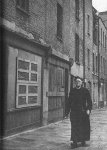
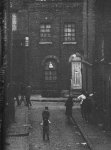
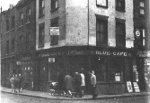 But it was as the 'prostitute's padre' that he came into the public eye. He
was indignant, and outspoken, particularly in the monthly parish
magazine The Pilot, about
the rise of public indecency. This
was the era of the 1957 Wolfenden
Report (on human sexuality) and the 1959 Street
Offences Act
(which drew attention to the way in which girls, some of them very
young, were trapped into
'moral danger'). They operated from the many cafés and clubs
along Cable Street which flourished until they were demolished under
the Graces Alley Compulsory Purchase Order of 1963 (partly because of
Father Joe's campaigning). The pimps were Arab, Ghanaian, Nigerian,
Maltese
but many of the girls were Irish or Welsh. Pictured right is
the corner of Cable Street and Ensign Street; prostitutes and their
clients off Cable Street in the 1950s; and Fr Joe walking the parish.
But it was as the 'prostitute's padre' that he came into the public eye. He
was indignant, and outspoken, particularly in the monthly parish
magazine The Pilot, about
the rise of public indecency. This
was the era of the 1957 Wolfenden
Report (on human sexuality) and the 1959 Street
Offences Act
(which drew attention to the way in which girls, some of them very
young, were trapped into
'moral danger'). They operated from the many cafés and clubs
along Cable Street which flourished until they were demolished under
the Graces Alley Compulsory Purchase Order of 1963 (partly because of
Father Joe's campaigning). The pimps were Arab, Ghanaian, Nigerian,
Maltese
but many of the girls were Irish or Welsh. Pictured right is
the corner of Cable Street and Ensign Street; prostitutes and their
clients off Cable Street in the 1950s; and Fr Joe walking the parish.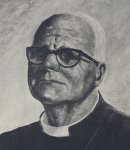 Assessment
Assessment How to assess his ministry? He was a faithful parish priest who had
proved the hierarchy wrong about his capabilities. He was much-loved by
many, and a source of exasperation to others. Fr Ken Leech, who worked
with him in the 1950s, commented (in a 2006 talk given at the merger of
UNLEASH and Housing Justice) Williamson,
like Josephine Butler, who inspired him, and about whom he wrote a
small book, used the language of 'rescue' constantly, yet he saw the
close link between prostitution and bad housing. He campaigned so
relentlessly against slum conditions that he got a good deal of his
parish neighbourhood demolished*. However, Williamson was not
politically astute, and often failed to make wider connections.
How to assess his ministry? He was a faithful parish priest who had
proved the hierarchy wrong about his capabilities. He was much-loved by
many, and a source of exasperation to others. Fr Ken Leech, who worked
with him in the 1950s, commented (in a 2006 talk given at the merger of
UNLEASH and Housing Justice) Williamson,
like Josephine Butler, who inspired him, and about whom he wrote a
small book, used the language of 'rescue' constantly, yet he saw the
close link between prostitution and bad housing. He campaigned so
relentlessly against slum conditions that he got a good deal of his
parish neighbourhood demolished*. However, Williamson was not
politically astute, and often failed to make wider connections.
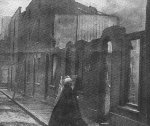
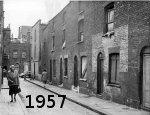 * Bulldozers are the only way to clear Stepney of its shocking vice, Fr Joe said. In a 2010 lecture for the Heritage of London Trust
on 'This Unfortunate and Ignored Locality: the Lost Squares of Stepney'
Will Palin lamented that Fr Joe stigmatised the whole area, and did not
discriminate between the true slums and centres of prostitution, such as Sander
Street, photographed by Frank Rust [right in 1957, showing Edith Ramsay, and for this article of 1 March 1961 in the Daily Mail], and Wellclose and Prince's
Squares, in the vicinity of the church and its school, which could have
been saved and restored, as happened in parts of Spitalfields. With
hindsight, we can argue that a 'clean sweep' of these areas was the wrong
answer; but at the time there was little will to save these squares on
heritage grounds when social conditions were so desperate.
* Bulldozers are the only way to clear Stepney of its shocking vice, Fr Joe said. In a 2010 lecture for the Heritage of London Trust
on 'This Unfortunate and Ignored Locality: the Lost Squares of Stepney'
Will Palin lamented that Fr Joe stigmatised the whole area, and did not
discriminate between the true slums and centres of prostitution, such as Sander
Street, photographed by Frank Rust [right in 1957, showing Edith Ramsay, and for this article of 1 March 1961 in the Daily Mail], and Wellclose and Prince's
Squares, in the vicinity of the church and its school, which could have
been saved and restored, as happened in parts of Spitalfields. With
hindsight, we can argue that a 'clean sweep' of these areas was the wrong
answer; but at the time there was little will to save these squares on
heritage grounds when social conditions were so desperate. | AN AFTERTHOUGHT Was Father Joe aware that the first English home for work with prostitutes, the Magdalen Hospital, was based a short distance away from Church House, Wellclose Square from 1758 to 1769? Its underlying philosophy and methods were quite different, but it was just as much in the public eye. The comparisons are intriguing. A century later, a few yards away in the other direction, in Betts Street, there was also a 'Refuge and Receiving Home', established in 1879 for 'rescue and preventative work among girls and children'. This was run by the Bridge of Hope Mission and linked to 'cottage training homes' at Chingford, to which girls who had been abused or become pregnant were taken. Ministry to streetworkers continues in the East End, particularly at St Matthew Bethnal Green. |